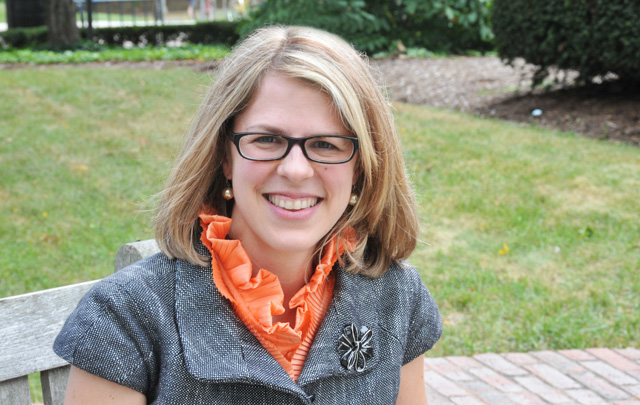5 Questions With . . . Government’s Erika Franklin Fowler

The issue we ask “5 Questions” of Assistant Professor of Government Erika Franklin Fowler, the director of the newly-launched Wesleyan Media Project, a non-partisan initiative designed to perform comprehensive tracking and analysis of federal and state political advertisements by candidates, parties and special interest groups in every media market in the nation.
Q: What can you tell us about the Wesleyan Media Project?
A: The Wesleyan Media Project will provide nonpartisan, publicly-available, real-time tracking and analysis of all political ads aired on television across the U.S. during the 2010 election campaign. It’s a collaborative effort lead by me and two colleagues, Professor Mike Franz at Bowdoin College and Professor Travis Ridout at Washington State University, which builds on the technology provided by Kantar Media’s Campaign Media Analysis Group (CMAG). CMAG’s technology uses market-based “ad detectors” to find each instance of an ad airing and records frequency information (the date, time, market, station, and program on which each ad aired), which allows for an accurate estimate of the cost at the market level. The end result is a massive database that gives us precise information on who is airing ads, in which markets, during which times, at what cost, what exactly is being said, and which candidates are benefiting.
Q: How is this different from the work you did at The University of Wisconsin?
A: The Wisconsin Advertising Project was a source of information on campaign advertising from 1998 to 2008. During my time in Madison, I served as the research director of the WiscAds’ sister project, the University of Wisconsin NewsLab, which was the one of the largest and most systematic local TV news tracking projects ever conducted. More Americans report getting their news from local TV news than from any other source including network news, cable TV, radio, newspapers, and even the Internet. Yet, prior to our work with UW NewsLab, there was very little systematic evidence detailing the political information available from that source. Much like the political advertising work, we issued real-time information through three election cycles, 2002, 2004 and 2006, on the extent of election information available on each of the stations we tracked. Although there was variation between stations in the volume of election news available to help citizens make decisions, campaign news is almost always outweighed by the paid ad messages aired by and on behalf of candidates for office during commercial breaks.
Q: How did you become involved in analyzing political advertisements?
A: It was largely due to Professor Ken Goldstein, former director of the Wisconsin Advertising Project and UW NewsLab, who took me on as a research assistant the summer after my first year of grad school. During the summer before getting the news project off the ground, Mike Franz and I went to New York to help Ken put together evidence for his expert witness testimony in the court cases challenging the Bipartisan Campaign Reform Act. Mike, Travis, and I are all former graduates of Wisconsin (go Badgers!) who worked closely with Ken on the Wisconsin Advertising Project, and we are honored to be taking it over. We are especially grateful for his generosity and for the support of our respective institutions, especially Wesleyan, who stepped up to provide a home for the project. In addition, the Project would not have been possible without the early support of Sunlight Foundation and the generosity of the John S. and James L. Knight Foundation.
Q: What do you hope to reveal during this election cycle, especially in light of the Supreme Court Ruling that allows unions and corporations to fund ads for specific political candidates?
A: In the wake of the Supreme Court’s decision in Citizens United v. FEC, which paved the way for unlimited corporate and union spending in federal election campaigns, knowing which interests are attempting to influence election outcomes takes on additional significance. Many are concerned not only that the floodgates of corporate and union treasuries will amount to even more negativity on the airwaves but also that the decision will translate into less influence for the average citizen. One way we can help empower citizens, journalists, and scholars is by improving transparency through publicly available information detailing the extent, content and targeting of corporate and union spending.
Q: With a presidential election cycle starting virtually the day after this year’s election ends, how do you see the Wesleyan Media Project evolving over the next two years?
A: Our first priority is making the most of this cycle, but we are actively looking for funding to support future election cycles, and the 2012 presidential race, as you mention, not only starts early but will also suffer from the same lack of transparency without the real-time tracking we can provide. Fortunately, it is easier to ask for funding for a project in which you believe. Not only does the Wesleyan Media Project provide a public service to citizens, journalists and scholars, but it is also enormously rewarding to Wesleyan students, both those who work directly with the Project and those in the classroom who benefit from the incorporation of real-time examples. Students get exposure to both the rigors of academic research and the pressures of real-time data collection, which are invaluable experiences regardless of the career path they choose after graduation. It is our sincere hope that the Wesleyan Media Project is around for a long time to come, and should we be so fortunate as to secure early support for the next few cycles, we plan to work on other ways we can expand the Project to include the intersection of advertising and news coverage, much as the WiscAds and UW NewsLab projects once did.

